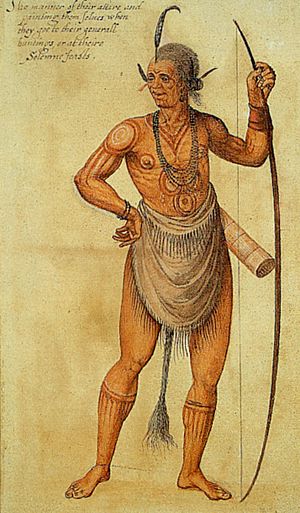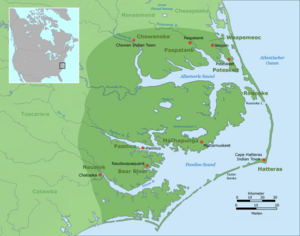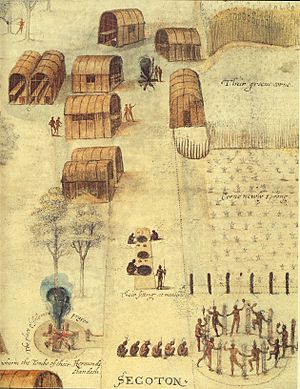Secotan facts for kids
The Secotans were a group of Native American people who lived in the Carolina sound region between 1584 and 1590. They were one of several important groups in the area that the first English colonists met. Secotan villages included Secotan, Aquascogoc, Dasamongueponke, Pomeiock (also called Pamlico), and Roanoac. Other nearby groups were the Chowanoke, Weapemeoc, Chesapeake, Ponouike, Neusiok, and Mangoak (Tuscarora). All these groups lived near the Albemarle and Pamlico sounds. The Secotans spoke Carolina Algonquian language, which is part of the Eastern Algonquian language family.

Why Europeans Came to the Carolinas
When Europeans started coming to the Carolinas, it wasn't a simple change from Native American rule to European rule. There was a lot of competition between the English and the Spanish, who were the two main European powers. Native American groups also had their own rivalries. Sometimes, the Europeans even got caught in the middle of these Native American conflicts. Everyone, whether European or Native American, put their own group's interests first.
The English and Spanish were rivals in Europe, and this rivalry extended to North America. The Spanish were the first Europeans to set up colonies in the Carolinas. In 1567 and 1568, a Spanish captain named Juan Pardo claimed that groups like the Catawba, Wateree, and Saxaphaw were under Spanish rule. He convinced them to build homes and gather food, which led to eleven Spanish settlements in the Carolinas. The Spanish were still living in the Carolinas when the English arrived.
The English wanted to start their own colonies in North America. They hoped this would help them get goods without relying on Spain. In 1585, Richard Hakluyt wrote a book suggesting that England should create its own colony in the middle parts of North America. This would allow England to get its own supplies. In April of the same year, Sir Richard Grenville left England with 100 colonists, heading for the Carolina coast. This was the start of England's efforts to colonize America. While the Spanish settled more inland, the English arrived on the coast. The first English colony in North America was at Roanoke.
First Meetings: Secotans and Neusiok
Before the English built their first settlement on Roanoke Island, two men, Master Philip Amadas and Master Arthur Barlowe, explored the area. They were sent by Sir Walter Raleigh in April 1584. Barlowe wrote detailed notes about the conflicts between different Native American groups.
In one story, Manteo, a leader of the Croatoan people (also known as Hatteras), told Barlowe about his tribe's history with a neighboring group called the Neusiok. Manteo said the Croatoan had been fighting the Neusiok for many years. He explained that some years before, he had met with the Neusiok king to try and make peace. The two leaders arranged a feast between their groups. Many Neusiok men and thirty women came to the feast in the town of Croatoan. However, the Neusiok attacked the Secotans during the feast. By the time the fighting ended, the Neusiok had killed everyone except the women and children.
Manteo shared this story with Barlowe because he saw a chance to help his own people, the Croatoan. Manteo and his people tried several times to get the English to join them in a surprise attack against the Neusiok. The Englishmen weren't sure if the Croatoan wanted revenge or truly cared for them, so they decided not to help. Instead, the English built a trusting relationship with the Croatoan. As a sign of this trust, Manteo and another Croatoan man named Wanchese agreed to go back to England with Amadas and Barlowe.
What Happened Later

The Secotan people stayed in the same area until 1644-1645. At that time, colonists from the Virginia Colony attacked them. This happened during the last of the Anglo-Powhatan Wars, which were conflicts between English colonists and Native American tribes. After this, English settlement in the area grew quickly. The land was officially moved from the Virginia Colony to the Province of Carolina in 1665. In later years, the Secotans were recorded under a new name, the Machapunga.


